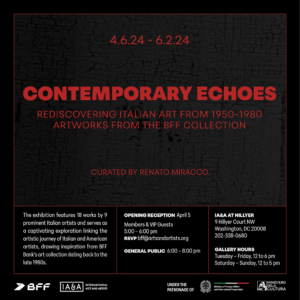She Says, Her Story: Notes on the Female Gaze
by Timothy Brown, Hillyer Director

The exhibition She Says, Her Story: Contemporary Women Artists from Taiwan, is an eye-opening tribute to the female gaze. The exhibition’s curator, Yu-Chuan TSENG, notes that during the nineteenth century, female artists were defined as “women in the bedroom.” This patriarchal view of the “male gaze” depicts women as passive rather than active, objects rather than subjects. In his analysis of European paintings, John Berger noted how this active/passive dichotomy is deeply rooted in Western art: “Men act and women appear. Men look at women. Women watch themselves being looked at” (Ways of Seeing, 1972). The feminist theorist Laura Mulvey found the same binary structure in cinematic representations, which places women in an asymmetrical power relationship that constructs pleasure for the male viewer:
Woman then stands in patriarchal culture as a signifier for the male other, bound by a symbolic order in which man can live out his fantasies and obsessions through linguistic command by imposing them on the silent image of woman still tied to her place as bearer, not maker, of meaning. (Visual Pleasure and Narrative Cinema, 1975)
These perspectives are informed by Sigmund Freud’s notion of scopophilia (the pleasure in looking), Lacques Lacan’s concept of the “mirror stage” (when one’s reflection becomes a substitute, or “misrecognition,” of the other), and the French concept of the “flâneur,” which places the male subject in the position of the all-seeing eye, yet remaining invisible: “The spectator is a prince who everywhere rejoices in his incognito” (Charles Baudelaire, “The Painter of Modern Life,” 1863). In summary, patriarchy establishes the male gaze as a normative way of seeing the world, grounded in a symbolic universe that objectifies women, while marginalizing female voices.
Trinh T. Minh-Ha offers a similar critique of this tradition in the context of Asian women and the binary trap that binds them:
In the realm of dualities where blinding brilliance is opposed to mysterious luminosity, or to use Taoist terminology, where the logic of conscious knowledge is set against the wisdom of real knowledge, she finds no place she can simply dwell in or transgress. (When the Moon Waxes Red,” 1991)
What does the term “female gaze” mean in the context of a patriarchal tradition? Some argue that the “female gaze” and the feminist interventions set out to overturn the canon which has defined our traditions and values.
What does the term “female gaze” mean in the context of a patriarchal tradition?
Norma Broude and Mary Garrard suggest that the goal is not to replace but to expand the discourse about art and gender representation, without resorting to “binary thinking” and “refusing to be trapped by theoretical absolutes” so characteristic of patriarchal culture (“The Expanding Discourse: Feminism and Art History,” 1992). Based on these insights, the “female gaze” is recognized as a way to expand how we see things, informed by a diversity of perspectives that are rich in subjective, historical, cultural, and intergenerational complexity.
Similarly, She Says, Her Story represents a collection of visual narratives by six contemporary female artists from Taiwan that supersede monolithic views of the male gaze by offering intergenerational stories that navigate and investigate the boundaries between reality and imagination, history and myth, past and present, and loss and recovery. These intersections enable female artists to explore freely the vicissitudes of time and space, to recover from loss, to share private moments publicly, and to reclaim the memory of the shamed and the forgotten. As Trinh T. Minh-Ha suggests, this in-between space can be empowering:
A trajectory across variable praxes of difference, her (un)location is necessarily the shifting and contextual interval between arrested boundaries. (“When the Moon Waxes Red,” 1991)

Among the six artists in the exhibition, Wen-Jen DENG weaves together migratory maps that explore her aboriginal roots in Taiwan and the intersection of history (“The Rover Incident”), myth, and legend. Ping-Yu PAN creates an installation of “family recipes” that serve as mythical archetypes and visual signs of love and healing. Ya-Lan YU uses woodcuts to capture indelible impressions of her mother, Madame Chung, who is no longer with us, yet whose persistent memory remains in the family and friends she represents. I-Chun CHEN uses video animations and arresting music to uncover the real and imagined life of her grandmother, Wang Shih, who was abandoned by an elite family, yet whose memory endures amid conflicting narrative accounts. Jui-Hung NI creates colorful light boxes that explore the intersection of ancient Chinese goddesses (notably Xiwangmu) and women of the Internet, inspirational guides that connect across time to support women and their aspirations. And Yi-Hsin TZENG takes us on a journey with Miss Circle and the Triangle, adopting the classic technique of cun (wrinkles) to show how landscapes (in the tradition of Chinese scrolls) emerge from the crevices of our memories and imagination.
As Trinh T. Minh-Ha suggests, these intervals function as a “safe space” in which to speak the unspeakable, a positionality that is reinforced by strong emotional connections and boundless love. As the curator, Yu-Chuan TSENG, concludes:
I feel that women always deeply integrate their emotion into the creative and research process. In the process of creation, they devote themselves into the story with love. They show compassion when they observe. Watch their works. You can feel not only the dedicated observation ability, but the meticulous creative skills and abundant emotion. They are not only telling a story, but also responding to the subject and their life experiences.
Timothy Brown
Hillyer Director
She Says, Her Story: Contemporary Women Artists from Taiwan will be on view at the Hillyer from November 6 through December 19. The exhibition is sponsored by the Ministry of Culture, Republic of China (Taiwan), and coordinated by International Arts & Artists, INFODATE Association (Taiwan Information, Design, Technology, and Education Association), and Taiwan Academy.

